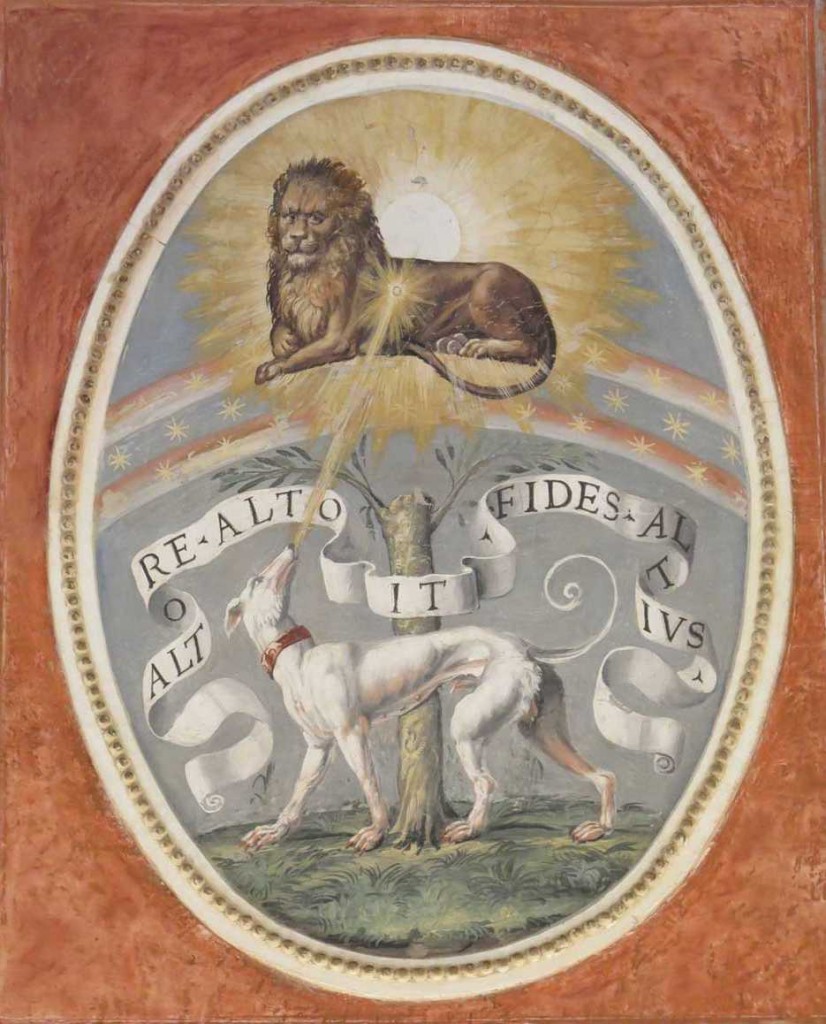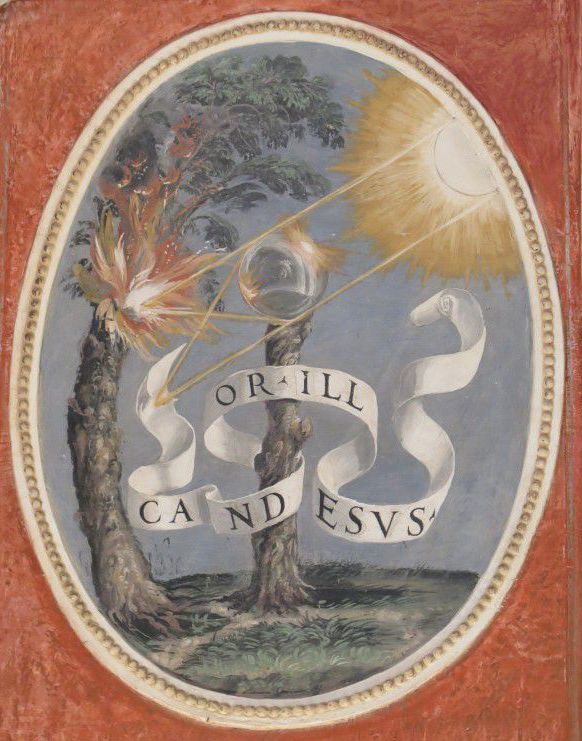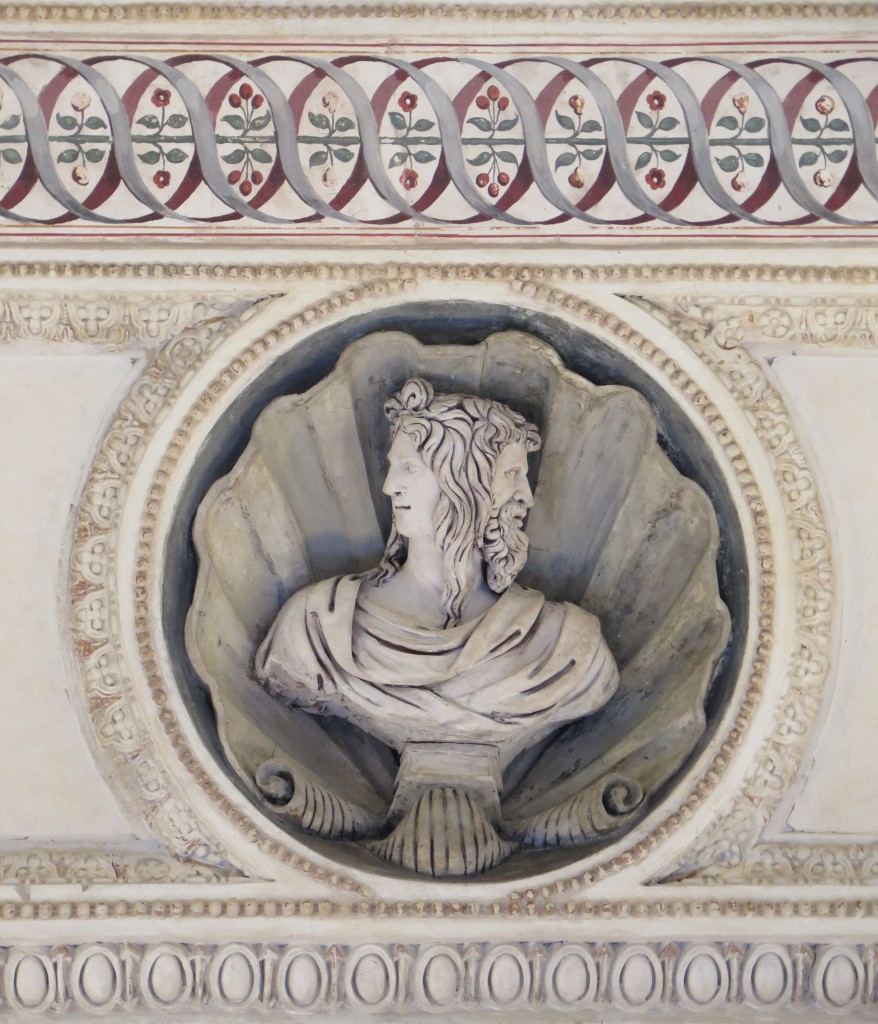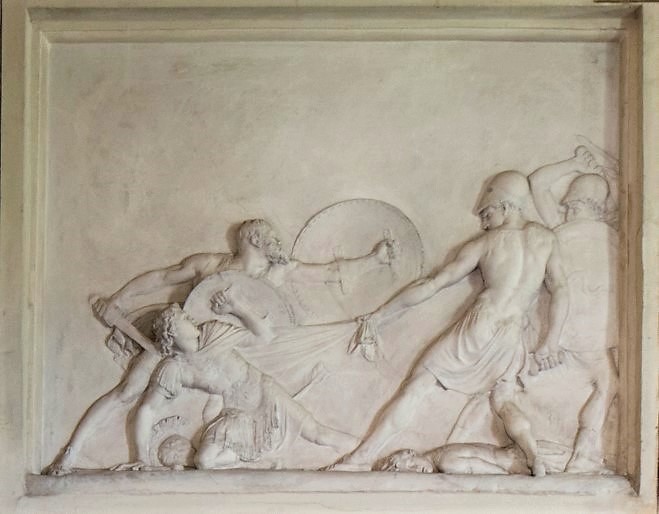Giorgio Vasari writes in the second edition of his artist biographies (1568) that Giulio Romano was responsible for the frescoes inside Villa Lante. Current research suggests that the frescoes in the salone were painted by Polidoro da Caravaggio and Maturino, members of Raphael’s school.
Impresas
The ceiling of the salone still bears the impresas, or emblems, of Baldassarre Turini and his patrons, Pope Leo X and Clement VII. Turini’s own impresa features the Latin motto ALTORE ALTO IT FIDES ALTIUS (something like “the higher the lord, the greater the loyalty”) and a greyhound facing a lion. The animals are connected by beams of light leading from the lion’s heart to the hound’s mouth.
The interpretation is clear: the greyhound is the symbol of Turini and on the family coat of arms, which has been preserved in the garden of the villa and on Turini’s funerary monument in Pescia Cathedral.
The lion refers to Leo X and the Medici family, as do the laurel leaves in the background. The motto underlines Turini’s great loyalty to Leo X: before he was elected Pope, Turini had even accompanied him into a military prison in 1512.
Pope Leo X’s mottos, SUAVE (“easy, pleasant”) and SEMPER (“always”), are in stucco relief. The suave impresa features an image of a yoke, and refers to the Biblical phrase iugum meum suave, “my yoke is easy” (Matthew 11:30), and the Medici’s “easy” return to Florence after 18 years of exile. The motto semper, surrounding a ring, dates back to the time of Cosimo “il Vecchio,” founder of the Medici family.
Clement VII’s oval, painted impresa bears the words CANDOR ILLESUS (“integrity is not harmed”) and an image of the sun’s rays shining through a crystal ball, setting fire to the wood but not to the white ribbon.
The same impresa can be seen in the rooms painted by Raphael in the Vatican Museums and in other Medici buildings, such as Villa Madama. The symbol refers to Pope Clement’s steadfastness in the face of his enemies.
In the centre of the ceiling is the large coat of arms of Pope Paul V, a member of the Borghese family (black eagle and white dragon)
He visited the villa in 1608, when it was already owned by his relatives, the Lantes. The coats of arms repeated in the corners of the ceiling are also signs of family ties: the Borghese eagle and dragon are associated with the three white eagles of the Lantes. These decorative elements were probably added during the time of Cardinal Marcello Lante (1569–1652), as the coat of arms of his mother’s family, the Maffei, is in the north-east corner. The Cardinal’s own coat of arms is on the ceiling of the side rooms.
According to Henrik Lilius, the iconography of the ceiling paintings in the salone is directly linked to the Medici propaganda that the election of the Florentine Giovanni de’ Medici as Pope Leo X ushered in a new “golden age” in Rome.
Original frescoes
The four frescoes that once decorated the ceiling are now in Palazzo Zuccari, home to the Bibliotheca Hertziana, the German art history institute. They are based on the ancient myths and legends related to the Janiculum hill: the encounter between Janus and Saturn, the discovery of the tomb of Numa Pompilius, Cloelia’s escape, and Cloelia’s release. The ceiling contains 32 smaller frescoes depicting amorinos (cupids) and subjects from mythology.
The first ceiling fresco depicts the encounter between the two-faced god Janus and Saturn on the Janiculum hill before the founding of the city of Rome. This meeting marked the beginning of the golden age of Antiquity, which in the early sixteenth century was equated with the election of Leo X to the papal throne. Giles of Viterbo, a prominent cleric and scholar at the court of Leo X, compares Janus as the founder of the Etruscan religion to Saint Peter, the founder of the Roman Church. According to Vierboline’s contemporary Giovanni Nanni (Annio da Viterbo), in the original Golden Age, Janus ruled Etruria together with Saturn.
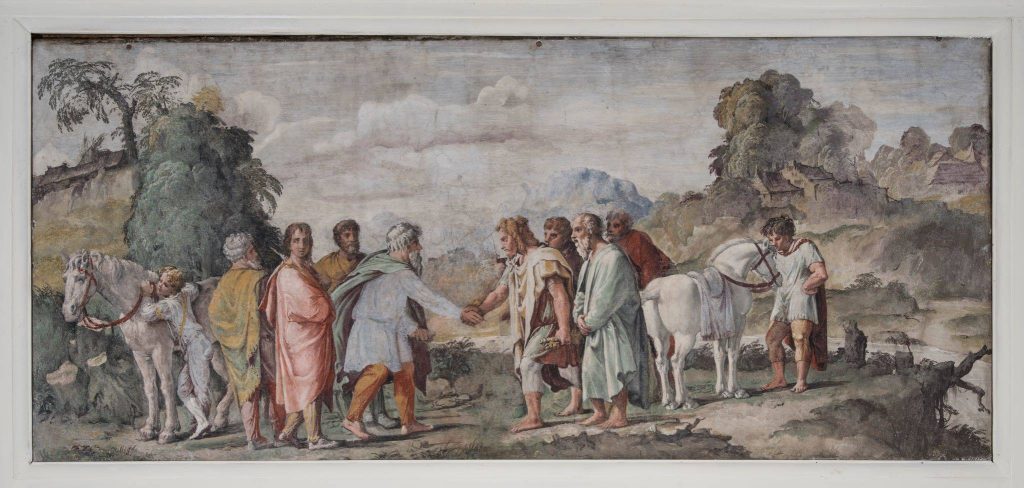
The second fresco depicts the discovery of the tomb of Numa Pompilius on the Janiculum hill. Numa Pompilius was the legendary second ruler of Rome, successor to Romulus. He also ordered religious life in early Rome, was the author of its laws and the first high priest, pontifex maximus. The story goes that about 500 years after his death, in 181 BC, two coffins were discovered at the foot of the Janiculum hill, one of which was Numa’s tomb while the other contained his law books or, according to another version, books of the sibyls’ prophecies. The image shows books being lifted from the grave and – transcending time – the newly built Villa Lante in the background. Again, the link with Pope Leo X and his central role in the religious life of the Romans is clear, since the popes also bear the title pontifex maximus.

The third and fourth frescoes depict the legend of a girl called Cloelia dating from the early days of the Roman Republic. The Etruscan king Lars Porsenna had set up his camp on the Janiculum hill during the war against Rome. As collateral for the peace treaty, the Romans were forced to hand over a group of girls, including the noble Cloelia, as prisoners to the Etruscan camp. Brave Cloelia arranged for the prisoners to escape from the camp by swimming across the Tiber River.
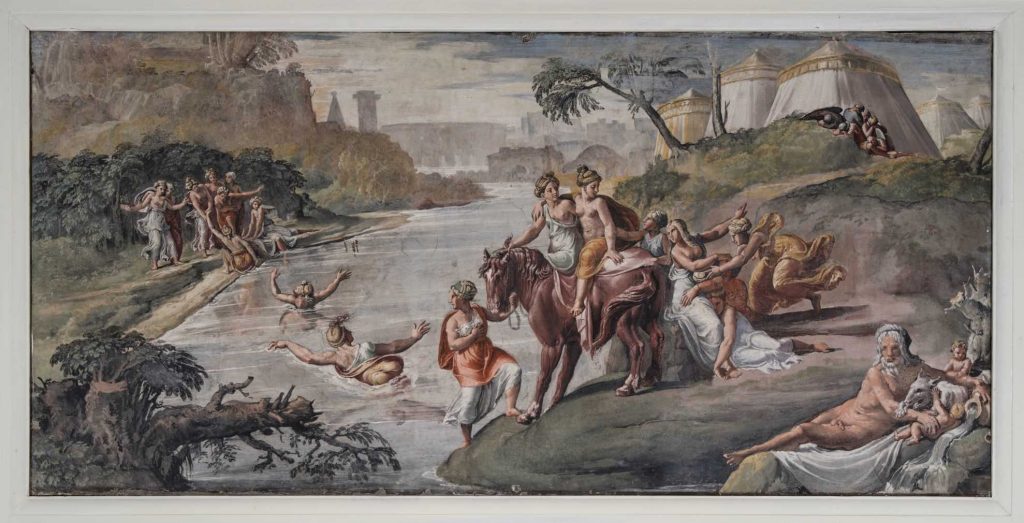
The honourable Romans returned the girls to Porsenna’s camp, where Cloelia shouldered the blame for the escape but vowed to flee again. Impressed by the Romans’ sense of duty and Cloelia’s courage, Porsenna released the girls. This story can also be linked to Medici propaganda. The peace between the Etruscans and the Romans is compared to the alliance between Rome and Florence under Leo X.

In their original positions on the ceiling, portraits moulded from stucco in shell-shaped frames directly relate to the frescoes. Above the windows are the two-headed Janus and bearded Saturn. On the south side are the protagonists of the war between the Etruscans and Romans: the Roman maiden Cloelia and the Etruscan King Lars Porsenna, in fine armour. Above the mantelpiece is another bearded man, possibly Numa Pompilius, and a female figure, perhaps Vesta, whose cult was created in Rome under Pompilius, or his wife, the water nymph Egeria. On the east (loggia) side is the young wine god Bacchus, with his bunch of grapes, and his wife Ariadne, with a ribbon across her bare breast. These characters probably refer to the vineyards belonging to the villa, the joys of life there, and the pleasures of drinking wine.
Walls and reliefs by Canova
The walls of the salone are painted to look like slabs of precious coloured marble, modelled on ancient imperial buildings such as the Pantheon. During the restorations some of this painting was restored, while other walls were left in their neoclassical state to mark the alterations made by the architect Giuseppe Valadier in 1807. Other features introduced under Valadier are the plaster reliefs by Antonio Canova above the doors, with the themes “Socrates at the Battle of Potidea” and “Socrates bids farewell to his family” (west wall, on either side of Valentin de Boulogne’s painting)’; “The Birth of Bacchus” and “The Death of Adonis” (south wall); “Teaching the ignorant” and “Feeding the hungry” (east wall, loggia side).
Valentine de Boulogne’s painting
The impressive oil painting is Allegoria d’Italia (originally called Historia d’Italia) by Valentin de Boulogne (1591–1632), a Frenchman who worked in Rome for many years. One of de Boulogne’s major works, its importance has been highlighted in several exhibitions. In 2016–2017, the painting was one of the highlights of the Valentin de Boulogne exhibition at the Louvre in Paris and the Metropolitan Museum of Art in New York. The painting was acquired for Villa Lante by the archaeologist Wolfgang Helbig in 1899, at an auction in Palazzo Sciarra. The crowned female figure, holding a spear and shield, is a personification of Italy. At her feet, the nuts and fruit symbolize the fertility of the land. Beneath her, two bearded, naked male figures represent the two great Italian rivers, the Tiber (symbolizing Rome and the Papal States, with the wolf and twins Romulus and Remus) and the Arno (Florence and Tuscany, with the lion). Valentin imitated Caravaggio with his strong contrasts of light and shadow. He was commissioned by Cardinal Francesco Barberini to paint this image for the Extraordinary Jubilee of 1628. In the top left-hand corner, a tree stump with a swarm of bees rising from it is a symbol of the Barberini family.
The painting is currently in an exhibition in Finland, at the Sinebrychoff Art Museum.

